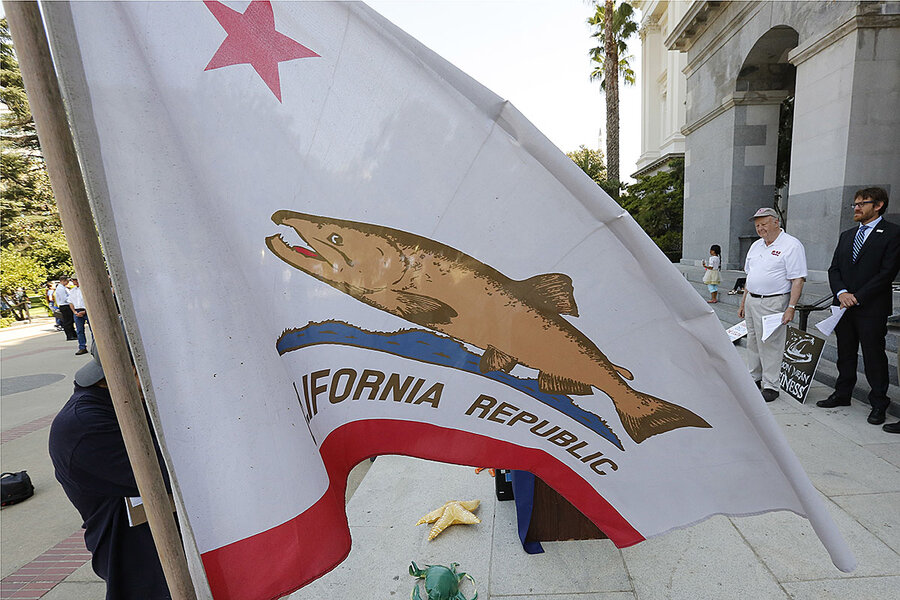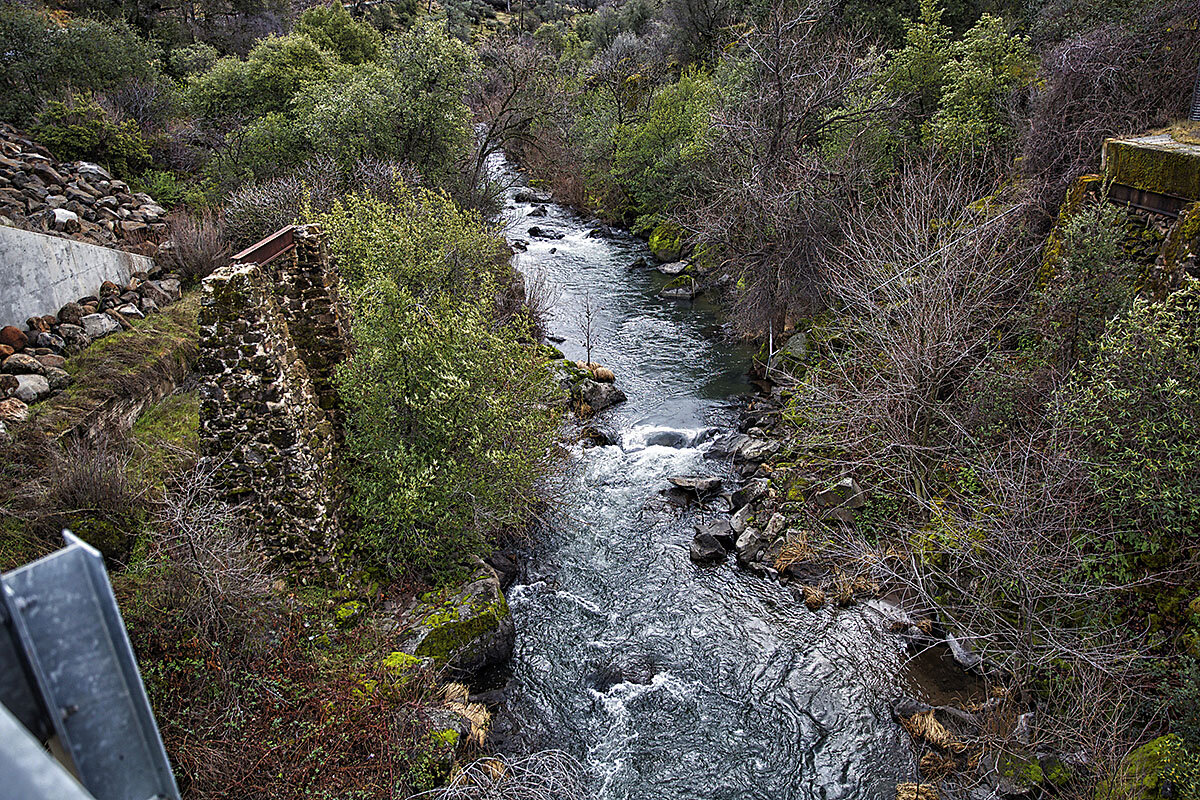Humans devastated California's chinook salmon. Now they want to save it.
Loading...
| Sacramento, Calif.
Dave Vogel already knew that levees and dams had devastated the coastal salmon population in California’s longest river. The surprise for the fisheries scientist arrived when he saw the video footage of young salmon clustered beneath bridges in the watery depths.
City and county agencies in Northern California hired Mr. Vogel to provide research on several bridge-construction and retrofit projects along the Sacramento River starting in the late 1980s. He surveyed the riverbed with radar and underwater cameras to gauge the potential impact of the bridge work on the California coastal chinook salmon, whose population has plummeted since the turn of the 20th century.
Prior studies found that juvenile salmon gravitated to the river’s shoreline for protection. Vogel’s videos instead revealed a fish tale of desperate adaptation born of the loss of habitat. The young chinook take refuge some 20 feet below the surface behind bridge piers and other artificial barriers, an imperfect alternative that still exposes them to bass, trout, and other predators.
Why We Wrote This
Public and private actors are working together to reverse the depletion of endangered salmon in California's largest river. One innovation being tried is a man-made underwater shelter for young salmon to hide from predators.
The footage gave Vogel an idea. Dams prevent tree debris from flowing downstream, depriving young fish of cover from predators and the swift current. He envisioned recreating the salmon’s habitat in deep water to help the fish mature and grow stronger, improving their odds of surviving to make the 300-mile migration to the Pacific Ocean.
Last year, two decades after that inspiration, tugboat crews installed 25 salmon shelters in the river near Redding, Calif., 160 miles north of Sacramento. Each six-ton shelter consists of large almond tree limbs or walnut root wads bolted to a massive limestone boulder. The protruding boughs and roots create a kind of maze that allows juvenile salmon to evade bigger fish and the current’s constant pull.
River Garden Farms, a family-owned, large-scale farm based on the river, invested $400,000 in the shelters and obtained a $200,000 federal grant for the three-year pilot project, the first of its kind in the country. The shelters count as one of dozens of projects planned, ongoing, or completed on the Sacramento River since the Northern California Water Association (NCWA) launched a salmon recovery program four years ago that builds upon earlier efforts.
“The old attitude was, ‘It’s going to take 100 to 200 years for nature to heal itself,’” Vogel says. “Now the attitude is, ‘Let’s start solving one problem at a time.’”
From drought grows cooperation
The US Fish and Wildlife Service listed the California coastal chinook salmon as threatened in 1999, five years after the Sacramento River’s winter run of the species received endangered status. The 447-mile-long river sustains four annual salmon spawning cycles — the only waterway in the world to hold that distinction — on the strength of its depth, food supply, gravel floor, and year-round cold temperature.
The winter salmon count has plunged from 25,000 in the late 1970s to 1,500, and the mortality rate of eggs, hatchlings, and juvenile salmon has reached as high as 95 percent in recent years.
But the effects of levees and dams, coupled with the ravages of climate change, agriculture, and development, imperil more than the river’s winter run. A report last year warned that almost half of California’s native species of salmon and trout in the Sacramento-San Joaquin River Delta and other major waterways could die off within 50 years.
Proposed solutions for restoring the salmon population have abounded for decades. Since an update to the delta’s water plan in 2000, the state has added tons of spawning gravel at various sites for female salmon to lay eggs and installed protective fish screens near dams and intake pipes.
The pace of progress quickened during a five-year drought starting in 2012 that sharpened concerns over the river’s health among public officials and the agriculture and fishing industries. The collective sense of urgency has enabled the NCWA to bring together a broader coalition for salmon conservation.
“The drought forced people out of their silos,” says Roger Cornwell, general manager of River Garden Farms, a 15,000-acre operation that relies on river irrigation to grow corn, rice, walnuts, and other crops. “The collaboration we’ve seen to help the salmon is the drought’s silver lining.”
Many of the Sacramento River projects shepherded by the association draw on a 2011 report authored by Vogel, who runs an environmental sciences consulting firm in Red Bluffs, Calif. He dropped his radar into the river last summer and again earlier this year and detected thousands of young salmon huddling around and flitting through the salmon shelters.
He will collect data and video over the next two years that could persuade public officials to extend and expand the project. In the meantime, he welcomes the eagerness of nonprofits and farm operators after years of inertia from government agencies in response to salmon depletion.
“These outside groups are much more ready to take calculated risks and use adaptive management,” Vogel says. He recalls the initial skepticism of state and federal biologists to the idea of salmon shelters. “They said, ‘We know that’s not going to work.’ Well, give us a chance to try.”
David Guy, president of the NCWA, regards the new spirit of cooperation as crucial to the salmon’s survival given that the most obvious answer to their plight — removing levees and dams — stands little chance of happening.
“We spent the last hundred years confining salmon,” he says. “Now we need to spend a hundred years unconfining them, so to speak, and that means working with each other and trying new things.”
A fish vs. farms truce?
The California Natural Resources Agency announced a plan last year to save three endangered species of fish in rivers and tributaries in the Central Valley watershed. The list includes the winter run of the chinook salmon in the Sacramento River, and the state’s strategies for restoring fish habitat and 6,000 acres of floodplains parallel concepts nurtured by the NCWA’s recovery program.
The idea to reestablish floodplains mirrors a project launched by the association last year that Mr. Guy hopes will cool the “fish vs. farms” conflict pitting environmentalists against the agriculture industry. Farmers complain that the state, attempting to preserve fish ecosystems, allows surplus river water to funnel toward the Pacific Ocean at the expense of crop irrigation.
The NCWA effort could demonstrate that restored floodplains serve the needs of fish and farmers alike. Scientists are working with farmers to flood rice paddies along the river to create simulated wetlands. When the farmers later drain their fields, the water carries added nutrients back to the river, aiding the growth of juvenile salmon preparing for the long journey to the San Francisco Bay and out to sea.
The flow of water replicates the cycle that existed before levees, dams, and development eliminated 95 percent of the region’s floodplain wetlands, and as the water level drops in the fields, farmers can plant crops. “They get to have their water and keep it, too,” says Peter Moyle, associate director of the Center for Watershed Sciences at the University of California, Davis.
Center researchers devised an earlier study in which they flooded part of a rice field bordering a river bypass between Sacramento and Davis. The water formed a temporary marsh that provided a refuge for young salmon to rest and feed, gaining size and strength far from predators before returning to the river.
The ephemeral wetlands, like the salmon shelters, represent small steps toward reversing more than a century of manmade devastation inflicted on the chinook salmon. Scientists caution that solving the crisis will require at least a generation or two even under ideal circumstances.
On the other hand, Moyle says, “It’s pretty clear what happens if we don’t do anything.”







